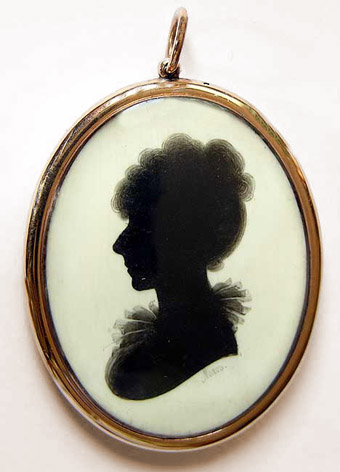Silhouette methods - painted on ivory
 Right, an ivory 'jewelry' by Meirs.
Right, an ivory 'jewelry' by Meirs.
Painting silhouettes on ivory is a relatively difficult and very expensive process. Traditionally it was reserved for the embellishment of jewellery pieces and small ornaments, such as brooches, tie pieces and snuff boxes. A very small number of cabinet-sized bust length pieces and wall hangings have been discovered, but these are in the minority. It is not a particularly popular technique amongst modern artists.
Silhouettes painted on ivory were most popular towards the end of the 18th and early 19th century. They were often set into jewellery pieces, as an alternative to a more traditional coloured profile. Important examples of this include ‘mourning rings’, which featured a portrait of a recently departed loved one, and lockets designed to hold a discreet profile of your betrothed. The black and white of profiles on ivory were considered particularly appropriate for mourning ornaments of all types.
Because of the expense and fragility of ivory, pieces tended to be small. Artists would typically take an outline with a machine, which was then reduced to the size of the profile. The brushes used to paint the silhouette were by necessity incredibly small, and artists would often use a specially designed machine to steady them as they worked. Ivory is generally a difficult medium to paint on; its naturally ‘oily’ surface requires treatment with an acidic wash if watercolour paint is to be used. The popularity of these pieces declined sharply in the late 19th century. The technique is rarely used today, as is appropriate, given that the ivory trade is now subject to the restrictions imposed by CITES (Convention on International Trade in Endangered Species of Wild Fauna and Flora).
